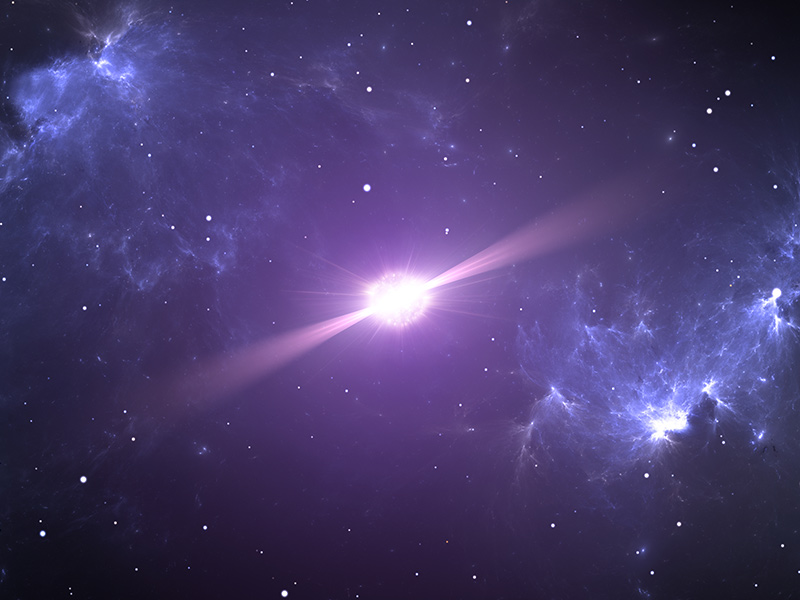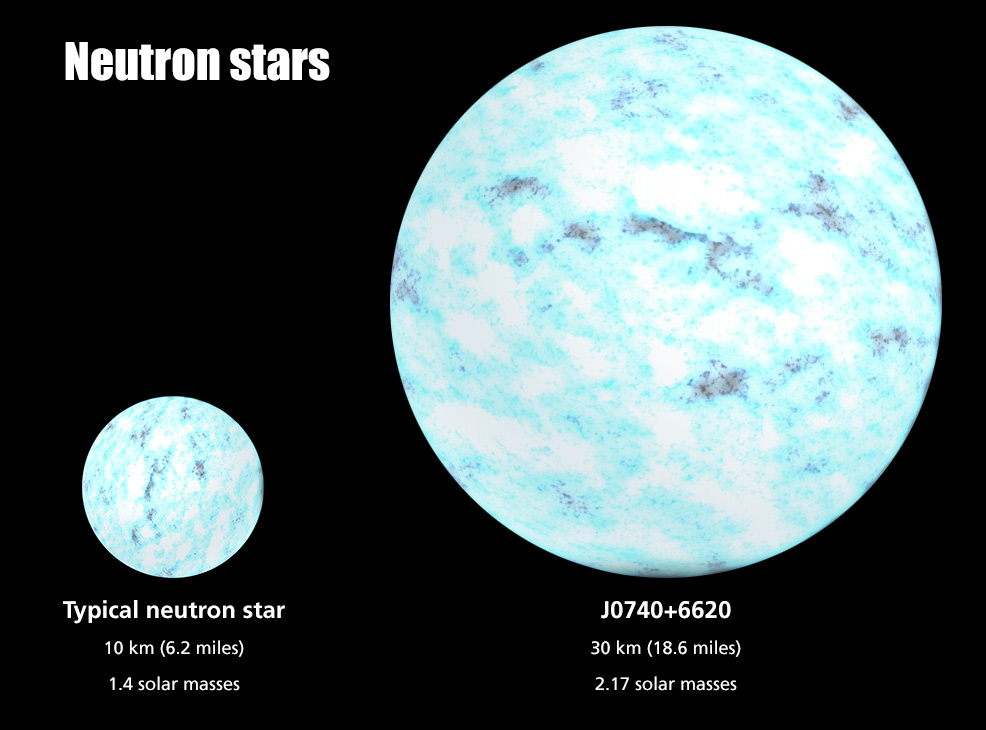
26th September 2019 Most massive neutron star ever detected A rapidly rotating millisecond pulsar, located 4,600 light years away, is the most massive neutron star ever observed – with 2.17 solar masses placing it on the boundary of the theoretical maximum.
Astronomers using the Green Bank Telescope (GBT) in West Virginia, USA – the world's largest fully steerable radio telescope – have discovered the most massive neutron star to date, a rapidly spinning pulsar around 4,600 light-years from Earth. This record-breaking object is teetering on the very edge of existence at or near the theoretical maximum mass possible for a neutron star. Neutron stars are the second densest known objects after black holes. They are so compact that even a fistful of one would weigh as much as a mountain. If held in your hand, this material would instantly crash to the ground, sinking far below the surface. The so-called "nuclear pasta" that forms deep inside neutron stars is the strongest known material in the universe – 10 billion times harder to break than steel. Neutron stars have incredibly long lifespans and are predicted to be among the last remaining objects in the universe. "Neutron stars are as mysterious as they are fascinating," said Thankful Cromartie, a graduate student from the University of Virginia and part of the team who made this new discovery. "These city-sized objects are essentially ginormous atomic nuclei. They are so massive that their interiors take on weird properties. Finding the maximum mass that physics and nature will allow can teach us a great deal about this otherwise inaccessible realm in astrophysics." The new object – designated J0740+6620 – packs 2.17 times the mass of our Sun into a sphere 30 km (18.6 miles) across. For comparison, the average size of a neutron star is 10 km (6.2 miles), with 1.4 solar masses. The theoretical maximum is called the Tolman–Oppenheimer–Volkoff limit, above which it can be assumed that a neutron star will collapse under its own weight and form a black hole. Recent work involving gravitational waves observed from the collision of neutron stars appears to suggest that 2.17 solar masses might be the maximum, putting J0740+6620 at the very edge of that limit.
The newly-discovered J0740+6620 is a pulsar, meaning it has twin beams of radio waves emitted from magnetic poles. These beams sweep across space in a lighthouse-like fashion, hundreds of times each second. Since pulsars spin with such phenomenal speed and regularity, astronomers can use them as the cosmic equivalent of atomic clocks. Such precise timekeeping helps in studying the nature of spacetime, determining the masses of stellar objects, and improving our knowledge of general relativity. J0740+6620 is part of a binary system, which also includes a white dwarf. With both stars nearly edge-on in relation to Earth, this cosmic precision provided a pathway for astronomers to calculate the mass of the two stars. As the neutron star beams its pulse towards the Earth, the passage of its white dwarf companion "warps" the space surrounding it, creating a subtle pause known as the Shapiro Delay. This is illustrated in the video below. The delay is exceptionally brief – on the order of 10 millionths of a second. However, this data is enough to calculate the mass of the white dwarf. Once the mass of one co-orbiting body is known, it is a relatively straightforward process to accurately determine the mass of the other.
The Green Bank Telescope, which is 100 metres (328 ft) in diameter, was constructed in 2002. Its previous discoveries include the Ophiuchus superbubble, a vast "cavity" carved out by multiple supernovae and stellar winds, containing hot hydrogen gas. Located 23,000 light years away, this region is so large that it extends beyond the plane of the galaxy. The telescope also detected a cloud of primordial gas that surrounds other galaxies, along with complex molecules such as sugar existing in space. Since 2016, it has been part of Breakthrough Listen, a project to search for intelligent extraterrestrial communications in the Universe. It can now add the most massive neutron star to its list of discoveries. "The orientation of this binary star system created a fantastic cosmic laboratory," said Scott Ransom, from the National Radio Astronomy Observatory (NRAO), astronomer and co-author on the study. "Neutron stars have this tipping point, where their interior densities get so extreme that the force of gravity overwhelms even the ability of neutrons to resist further collapse. Each 'most massive' neutron star we find brings us closer to identifying that tipping point and helping us to understand the physics of matter at these mind-boggling densities."
Comments »
If you enjoyed this article, please consider sharing it:
|








